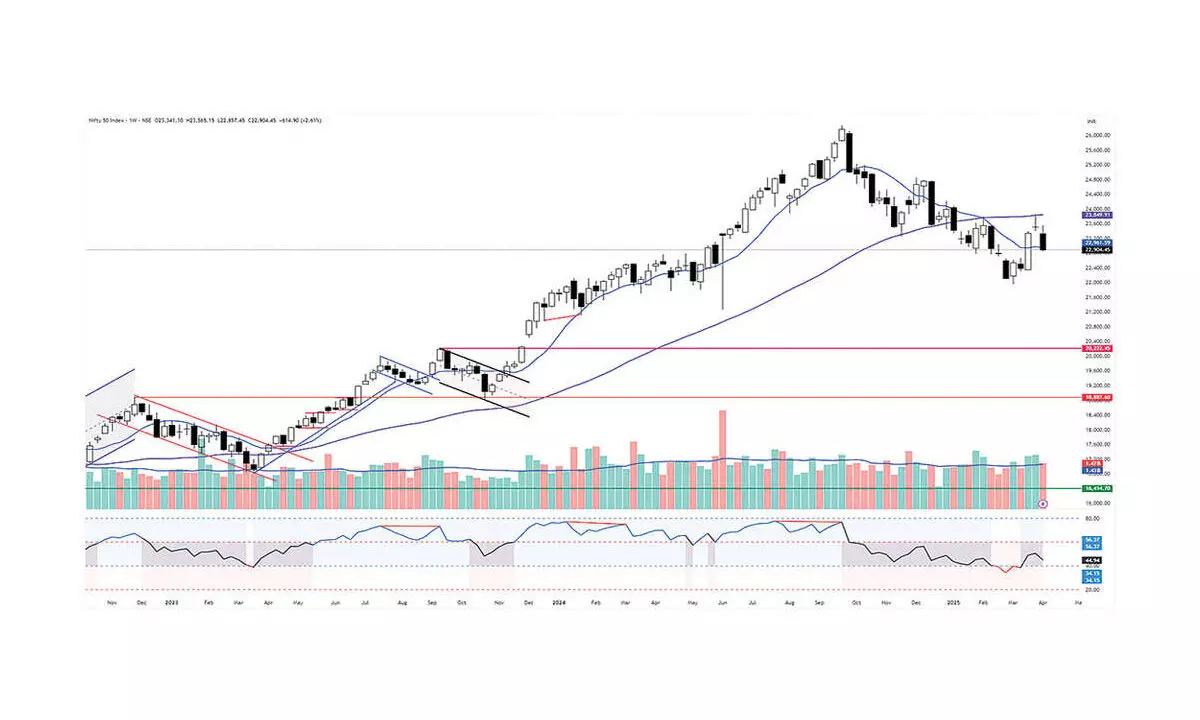The global equity markets closed deep in the red after the Tariffs imposed by Trump. The declines were intensified after China announced retaliatory tariffs. The Dow Jones down by 7.
86 per cent, S&P-500 declined by 9.08 per cent. The Nasdaq is nosedived by 9.

77 per cent. The fall was sharper after the March 2020 crash. The domestic equity benchmark indices losses were limited as NSE Nifty declined by 2.
61 per cent and BSE Sensex down by 2.65 per cent. The Mid-cap and Small-cap indices were outperformed by declining just 0.
34 per cent and 0.55 per cent, respectively. The Nifty IT index is the worst hit by 9.
15 per cent. The Metal index is down by 7.46 per cent.
And the Energy slipped by 3.76 per cent. The Media and FMCG indices gained by 0.
90 per cent and 0.45 per cent, respectively. The India VIX is up by 8.
16 per cent to 13.76. The FIIs sold Rs13,730.
49 crore, and the DIIs bought Rs5,632.56 crore worth of equities. The Nifty ended its two-week winning streak.
It closed below last week’s low and confirmed the Evening Star candle’s bearish implications. By closing below the 50 per cent retracement level of the prior upswing, the reversal signs were clearly visible. The index also closed below the 10-week average and 50-DMA.
It is also below the 100-DMA. In fact, the index closed below all short and long-term averages. It added two distribution days last week.
The Nifty closed below Tuesday’s low and given a bearish breakout of an inside bar. It also faced resistance at a 50-week average and formed Shooting Star Doji the previous week. As the global markets closed with deep cuts, expect a huge gap-down opening on Monday.
The previous six-day tight base area is crucial for now, which is at 22,668-314. At the same time, the first-hour range on Monday is also crucial. In any case, the index closes below 22,668 on a weekly closing basis, expect the correction will continue to below the previous low of 21,964.
The news flow will dominate the market sentiment for the next few weeks. The RSI has returned to the neutral zone on both the daily and weekly time frames. There are no divergencies visible.
The daily MACD is about to give a bearish signal. The ADX line is declining, and the -DMI is above the +DMI is a bearish sign. The KST line is flattened and about to give a bearish signal.
The Stochastic RSI turned bearish. The experts across the global market expect Black Monday (April 7). The world’s equity markets will likely stay under pressure next week.
The Indian government’s negotiations with the US on tariffs may result in some resilience in the domestic equity market. When there’re fears of global recession, we can’t be bullish. We live in an interconnected world; it is not surprising if we see the markets staying under pressure along with the other equity markets.
The pharma tariffs are about to be announced any time next week. The CBOE VIX spiked 109.14 per cent last week to 45.
31. On Friday alone, it is up by 50.93 per cent and reached March 2020 levels on a closing basis.
This is a warning sign of future volatility. Watch the developments closely. In a truncated (Thursday is a holiday) next week, the index may experience a wide trading range.
As mentioned earlier, the 23,350 is the strong resistance on the upside. A close above the prior day’s high indicates a positive bias. Expect the index to trade in the 22,350-900 range next week.
A break below will open the gates to a lower low below 21,964 points. Avoid highly leveraged positions. Watch the daily RSI below the 30 zones; we may get an early reversal signal.
(The author is partner, Wealocity Analytics, Sebi-registered research analyst, chief mentor, Indus School of Technical Analysis, financial journalist, technical analyst and trainer).
Business

RSI returns to neutral zone on daily, weekly time frames

The global equity markets closed deep in the red after the Tariffs imposed by Trump















